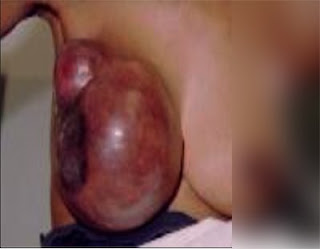There are four stages of breast cancer,and your diagnosis depends on the tumor's TNM rating. Here's how the stage and the TNM numbers relate.
Stage 1 means you have a T-1 tumor and clear lymph nodes with no evidence of metastasis, or T1N0M0.
Stage 4 is also called metastatic breast cancer, and is rated by having any size of tumor, positive lymph nodes, and obvious metastasis, for example T1N1M1.
Planning an Appointment with Your Doctor
Stage IV
Stage IV describes invasive breast cancer in which:
"Metastatic at presentation" means that the breast cancer has spread beyond the breast and nearby lymph nodes, even though this is the first diagnosis of breast cancer. Metastatic cancer is considered stage IV.
Additional staging information
You may also hear terms such as "early" or "earlier" stage, "later," or "advanced" stage breast cancer.
Early stage
Stage 0
Stage I
Stage II
Some stage III
Later or advanced stage
Other stage III
Stage IV
Doctors use a staging system to determine how far a cancer has spread. The most common system is the TNM staging system.
size (T stands for tumor)
lymph node involvement (N stands for node)
The T (size) category describes the original (primary) tumor:
Tis means the cancer is "in situ" (the tumor has not started growing into the breast tissue).
The N (node involvement) category describes whether or not the cancer has reached near
by lymph nodes:
N0 means nearby lymph nodes do not contain cancer.
The M (metastasis) category tells whether there are distant metastases (whether the cancer has spread to other parts of body):
For example, a T1, N0, M0 breast cancer would mean that the primary breast tumor:
does not have lymph node involvement (N0)
This cancer would be grouped as a stage I cancer.
Stage IV Breast Cancer
Patients diagnosed with Stage IV or metastatic breast cancers have disease that has spread from the affected breast to one or more distant sites in the body. The following is a general overview of treatment for metastatic breast cancer. Treatment typically consists of chemotherapy and/or hormonal therapy. The presence of hormone receptors in the breast cancer cells determines whether hormonal therapy is a treatment option. If the cancer does not have estrogen or progesterone receptors, the mainstay of treatment is chemotherapy. Treatment may also include surgery, radiation, targeted therapy, or a combination of these treatment techniques. Multi-modality treatment, which utilizes two or more treatment techniques, is increasingly recognized as an important approach for improving a patient's chance of cure or prolonging survival.
Hormonal Therapy
Chemotherapy
Targeted Therapy
Treatment for Stage IV Disease with Specific Characteristics
Treatment for Bone Metastases
Treatment of Local-Regional Recurrence
Treatment of Stage IV No Evidence of Disease
Strategies to Improve Treatment
Hormonal Therapy for Metastatic Breast Cancer
The growth of some breast cancer cells can be prevented or slowed by reducing the exposure to estrogen. This is the goal of hormonal therapy in the treatment for breast cancer.
Estrogen can also cause some cancers to grow. The breasts, uterus, and other female organs are composed of cells that are stimulated to grow when exposed to estrogen. These cells contain estrogen receptors. When cells that have estrogen receptors become cancerous, exposure to estrogen increases the cancer's growth. Cancer cells that have estrogen receptors are referred to as estrogen receptor-positive (ER-positive) cancers.
Currently, many women with estrogen receptor-positive breast cancer are initially treated with a drug called tamoxifen (Nolvadex), which blocks the growth stimulatory effects of estrogen. However, a new group of drugs, called aromatase inhibitors, have more recently been developed and approved by the FDA for the treatment of estrogen-positive breast cancer.
Aromatase inhibitors: Aromatase inhibitors work by inhibiting the formation of estrogen in the body. Aromatase inhibitors work by inhibiting aromatase, thereby reducing the levels of active estrogen in the body. Currently, three aromatase inhibitors are approved for the treatment of postmenopausal women with breast cancer: Femara® (letrozole), Arimidex® (anastrozole), and Aromasin® (exemestane). Research indicates that initial treatment of metastatic breast cancer with either Femara or Arimidex appears to produce better outcomes than treatment with tamoxifen. For more in depth information, go to Hormonal Therapy for Breast Cancer.







No comments:
Post a Comment